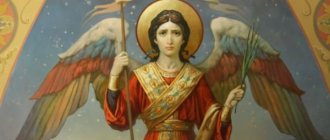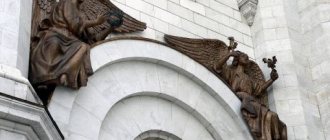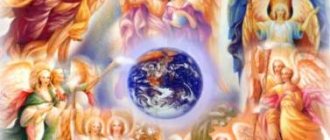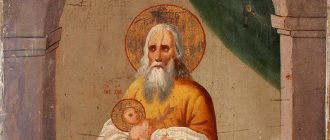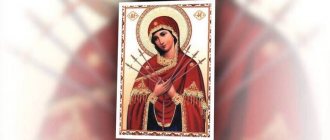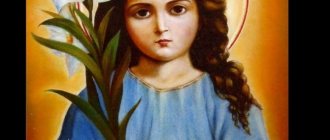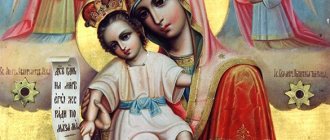The Orthodox faith reflects all the richness of the soul of a Russian person. For many people, she is a source of light and joy of life. These are prayers, singing akathists and a request for help addressed to the Lord, Christ and the Mother of God, as well as to the angels. Archangel Gabriel is one of the spirits who are greatly revered by Orthodox believers. He is not just an angel, this saint is endowed with the name of an archangel who has become the senior messenger of God. How Gabriel is depicted on the canvases of icon painters, who can pray to this archangel to receive help - we’ll talk further.
About Gabriel
In accordance with the biblical canons, one saint is considered an archangel; he is called Michael. But the traditions of the church over time came to recognize eight saints who had their own role.
The mission of Archangel Gabriel is a chief leading a group of saints who help people and bring news of the revelations of the Lord. This saint has a mission to guard the gates of heaven. Christianity also assigns the Archangel Gabriel the role of a messenger who carries the gifts of God’s secret knowledge to people:
- The Old Testament reports his appearance before the prophet Daniel to tell that Jesus Christ would soon be born;
- The Gospel tells of Gabriel’s appearance before Zechariah with the news of the birth of a son and that the baby’s mission is to be close to the Lord. For Zechariah, the archangel's words were not important, he ignored their meaning, so God punished him and made him dumb;
- According to legend, it was Gabriel who was given the mission to deliver the message that the birth of a daughter, the future Mother of Jesus, was expected to her parents, Joachim and Anna.
- Gabriel visited the Virgin herself twice: first to announce that she would have a son - this happened on the Annunciation, later - with the news that she would soon die. Some traditions mention that Gabriel was tasked with guarding Mary throughout her life, and it was he who conveyed the warning to Joseph that King Herod was plotting to kill Christ.
The meaning of Archangel Gabriel for the Jews
Gabriel (Heb. Gabriel) is one of the main four Archangels, especially revered in Judaism. These also include Raphael, Michael, Uriel. These Higher Angels are assigned to protect all four directions of the world. Each of them is on his own side of God's throne.
Jews turn to all four of the Highest Angels in prayer before going to bed. Each of the three tribes of Israel has Guardian Angels in the form of four Archangels.
Gabriel was assigned a particularly important task - to protect the entire Jewish people from enemies, to pray to God for mercy and to send forgiveness to the entire human race.
This heavenly seraphim is also assigned the role of messenger of the Heavenly Court. He appears in this image, in his hands with a straight, sharp knife, with the help of which he takes the souls of righteous believers worthy of the Kingdom of Heaven. Samael is sent for sinful souls, having a knife with jagged edges that causes hellish pain.
The saint is present in many world religions
Archangel Gabriel is also mentioned in the texts of books of other religions:
- Jewish - under the name of Gabriel. He and the three archangels were in the role of protectors, guarding the Lord's throne and the four cardinal directions. In prayer texts they are mentioned all together. Gabriel is also tasked with protecting the Jewish people from constant persecution and persecution. He must send prayers to the Lord to free the Jews from captivity and for there to be prosperity throughout the world. Archangel Gabriel, whose photo is offered below, is assigned the mission of being a good angel who takes the souls of the righteous at the time of death. His opposite is Samael, who comes for the souls of sinners and cuts out these souls with a knife with many serrations.
- In Islam - under the name Jibril. Here the archangel is also one of the four spirits close to the Lord and acts as a mediator between God and numerous prophets, among them Muhammad, whom Jibril had to:
– protect in confrontation with non-believers;
– accompany him during his travels;
– bless;
– help if disputes and wars occur;
- convey for 23 years the meaning of the revelation - the Koran.
The archangel is described as a tall man, with his head reaching the clouds. According to legend, he presented the earth to Allah so that he would create Adam and become his protector after being expelled from Paradise. Solomon learned from this archangel that John the Baptist was born, just like father Zacharias, for whom the archangel Gabriel also tried.
Service
Angels, like people, were created by God. But they have only a spiritual essence, and are constantly in the service of the Creator. People live in a bodily shell. After the Fall, they lost the gift of seeing the Lord. Therefore, sometimes He uses angels as messengers. The name Gabriel is translated as “power of God.” In Judaism, he is considered the teacher of Joseph, the guardian of the chosen people.
In Orthodoxy there is a classification of angelic ranks, there are 9 levels. Archangels occupy a high, but not supreme position. However, according to the holy fathers, although Gabriel is called an archangel, he belongs to the highest rank - the seraphim. This conclusion is based on the exceptional importance of his instructions.
What does the icon look like?
The icon of the Archangel Gabriel, who is especially revered in the Christian religion, is found in almost all churches. The presence of this image is mandatory for the Deesis. The Archangel can be depicted both on a common canvas, for example, on the Annunciation icon, and separately on sections of the altar gates, where this is provided for by the church charter.
Churches choose this face to depict Gabriel. In most cases, this is a golden-haired angel. He is dressed like a deacon to emphasize his mission to serve man. Gabriel's right hand bestows blessing upon the people, and his left holds the spear. This means that he will be able to defend.
In early paintings, the Archangel Gabriel is depicted in armor, which symbolizes his readiness to fight. There could be other items in his hands, depending on the mission being performed:
- A green branch that the archangel must give into the hands of the Virgin Mary as a sign of news from God.
- After a person sees the image of his soul in the mirror, he can hear the fiery word and be saved. With a lantern and a mirror - another option for depicting the archangel on icon canvases.
What was the first image of this saint? We'll talk about this further.
Some attributes
A characteristic combination is the gesture of blessing and a spear. With one hand he blesses humanity and each individual, and in the other he carries a spear, and such an object indicates the possibility of protection.
He protects (in every sense) people, and this symbolism is often complemented by the characteristic clothes of the deacon, which emphasize the function of serving humanity.
Archangel Gabriel is depicted in different ways and with different attributes. The icon, the meaning of which we are considering, can be interpreted depending on these attributes.
As stated earlier, there is a whole spectrum of what this heavenly hierarch helps and takes care of, that is, we are talking about a whole spectrum of functions. Therefore, the attributes are different, describing different options for the activity and symbolic meaning of this creature.
As a rule, he is depicted as a young man with abundant hair, which is supported by a special bandage, which is a sign of the readiness of the angels to always heed the divine will and command.
When a saint is honored
There are several days of the Archangel Gabriel in Christianity. They are celebrated three times throughout the year:
- In April, on the 8th. This holiday comes immediately after the Annunciation and implies the need to honor the memory of the Lord's messenger.
- In July, on the 26th. Repeated celebration, since this date is characterized by the consecration of the temple of the Archangel Gabriel in Constantinople in the 17th century.
- The cathedral dedicated to the Archangel Michael, the day of remembrance for all archangels - November 21. That’s when the Gavrilovs’ name day is celebrated.
Who can ask for help
Gabriel helps:
- When a woman wants to get pregnant - after all, it was this angel who told the Virgin Mary and Zechariah that they would have children.
- If you need to heal a serious illness, this saint will help with liver and kidney diseases.
- To cure infertility and maintain the health of the mother and her intrauterine child during pregnancy.
- To cleanse the soul clogged with fears and frightening thoughts, to heal from phobias, to calm thoughts and feelings.
- To regain faith and love, do not turn away from the true path.
- Punish the people who deceived you. For Gabriel, deception and betrayal are unacceptable.
- Get rid of mental illnesses and depression.
- Find happiness in marriage or find your love.
- Strengthen faith, fortitude, help follow the precepts of Christianity.
How to pray
Prayer to the Archangel Gabriel does not necessarily require following special canons or memorizing the text. It is important that it be sincere and come from the soul, and not be monotonously repeated without understanding the meaning.
Before asking for help, you need to pay attention to cleansing your thoughts and heart. To do this, you can wash your face and throw all the burdens of everyday life and negative thoughts out of your head, at least for a while.
To address Archangel Gabriel, it is not necessary to bear his name. This can also be done for relatives, especially if you need to ask the Lord for the baby, to give him talent and prosperity.
Angels are the army of Heaven
The Holy Scripture says: “In the beginning God created the heavens and the earth” (Gen. 1:1). Theologians understand by heaven, among other things, the invisible spiritual world or Angels. In the Bible, Angels, from the book of Genesis to the Apocalypse, are presented as forces acting at the command of God and protecting pious people with their cover at His command.
Angels are the army of Heaven and therefore the Gospel says about them: “And suddenly a large army of heaven appeared with the angel, glorifying God and crying: glory to God in the highest, and on earth peace, good will toward men” (Luke 2:13 13-14 ).
“Angel of Rublev” (miniature of the Khitrovo Gospel). Angels are the messengers of God, they proclaim to people the commandments of the Lord
The main task of Angels is to proclaim God's commands to people. That is why they are called Angels, that is, messengers. There are countless angels and the human mind is not able to count them.
Saint Dionysius the Areopagite, a disciple of the holy Apostle Paul, divides the Angels into nine ranks, and divides the nine ranks of Angels into three hierarchies - each with three ranks - the highest, middle and lowest.
Angels
this is the lowest rank in the Heavenly hierarchy, therefore the closest to people
The first, highest hierarchy, closest to the Holy Trinity, is: Seraphim, Cherubim and Thrones. Second, middle - Power, Dominance and Strength. The third represents the Principalities, Archangels and Angels.
Angels in the Heavenly hierarchy are lower than all ranks and closest to people. That is why stories about them can often be found in the Holy Scriptures.
Cathedral of the Archangel Michael and other ethereal Heavenly Powers (Novgorod icon, late 15th century). Archangels are those messengers of God who bring great news
Archangels are great evangelists who bring great news. They reveal prophecies, enable people to know the will of God, strengthen faith in people, reveal its sacraments, etc. So, for example, each person has his own guardian angel.
Over all nine Heavenly ranks of Angels, Archangel Michael was appointed by God as the official and leader, as a faithful servant of God. All the names of the Archangels are indicated in the Holy Scriptures and each of them has a special ministry before God.
These facts are interesting
Until recently, the image of the Archangel Gabriel in the company of saints, whom he guided on the true path, was practiced. The icon painters dressed Gabriel himself in rich attire, put a crown on his head, and gave a scepter in his hands.
After the 15th century, the image of the archangel in the company of the Virgin Mary, the queen of angels, became more popular. Gabriel was lucky enough to fulfill the mission of her subordinate. Then they began to draw a lily in his hands, replacing the royal signs with it. This flower has a symbol of purity, it means purity and spirituality.
Sometimes you can hear about the uniqueness of this angel, who is considered a woman. To confirm this, situations from the Bible are cited that indicate special support for children during the process of intrauterine development. But in the official religion, angels have no gender; they are all asexual beings, including Gabriel. Therefore, this version is not accepted.
Iconography and theological significance
According to iconographic tradition, Archangel Gabriel is depicted as a beautiful young man with a halo and wings. He is dressed in a long-skirted shirt - a chiton, the collar and wrists of which are stitched with gold threads. The color of the dress is white, as a symbol of the holiness and purity of the Archangel. On his shoulders, God's messenger wears a cloak in the shade of spring grass, for greenery is an indication of the eternal renewal of nature, and therefore of all living things.
Iconography: Gabriel, archangel. Dating: XVI century. Material: wood, gesso, tempera. Dimensions of the icon: height 131 cm, width 59 cm. Temple icon with the image of the Archangel Gabriel. KP 18. © Central Museum of Ancient Russian Culture and Art named after Andrei Rublev
No less often on icons you can see the Archangel Gabriel in deacon’s vestments: an orare - a cross-shaped ribbon thrown over the shoulders, and a surplice - a wide dress made of brocade. This type of liturgical clothing emphasizes the function of the Archangel serving the One who sent him with the message. The wings behind the back are a symbol of the speed required to complete the assignment.
Iconography: Gabriel, archangel. Dating: XVI century. Around 1517. Origin: From the cathedral church of the Holy Life-Giving Trinity of the Filippo-Irapa Hermitage. Material: wood, tempera. Dimensions of the icon: height 94 cm, width 36 cm. Icon from the Deesis. Full-length image of Archangel Gabriel in a three-quarter turn. Entered the museum in 1927. Restoration: State Russian Museum, 1959, restorer – Konenkov S.F. Inv. No. 280/4. © Cherepovets Museum Association Literature: Kulikova O.V. Ancient faces of the Russian North. From the museum collection of icons of the XIV-XIX centuries of the city of Cherepovets. M., 2009. Cat. No. 21
The Divine Herald is easily recognized by the lily flower or palm branch in his right hand, symbolizing in the first case sinlessness, and in the second - good news.
Iconography: Gabriel, archangel. Dating: XV century. Third quarter of the 15th century. Origin: From the Church of St. Blaise on Volosovaya Street in Novgorod. Material: Wood, tempera. Dimensions of the icon: height 152 cm, width 54 cm. From the Deesis tier. Full-length image of Archangel Gabriel in a three-quarter turn. NGOMZ 11167. © Novgorod State United Museum-Reserve. Literature: Icons of Veliky Novgorod of the 11th - early 16th centuries. The authors of the project are L.V. Nersesyan and S.V. Obukh. M. Northern pilgrim. 2008. No. 32.
Among other attributes and elements of the Archangel’s vestment are:
• a rod or scepter, as a symbol of the power given to him by God; • the mirror sphere, because human destinies are open to him; • a lit lantern is a sign of the invisible light of God; • a tiara, or rather its simplified version - a ribbon tied around the head with a large precious stone in the center above the forehead. Its fluttering ends symbolize obedience to God.
Useful materials
New Testament subjects in iconography
Iconography: Annunciation of the Blessed Virgin Mary. Dating: XVI century. End of the 16th century. Material: wood, gesso, tempera Icon dimensions: height 53 cm, width 45 cm. One of the most common subjects in Christian art. Known since the 5th century. The basis of the image is the Gospel of Luke, the Proto-Gospel of James and other writings. The scene of the Annunciation of the Blessed Virgin Mary is presented against the backdrop of an architectural landscape. On the left is the Archangel Gabriel bringing the Good News to the Most Holy Theotokos, seated on the throne on the right side of the icon. KP 0175. © Central Museum of Ancient Russian Culture and Art named after Andrei Rublev
A number of icons reproduce gospel stories:
- the Gospel of Luke says that as punishment for disbelief in his words, Archangel Gabriel condemned Zechariah to muteness exactly until the day the destined thing came true;
- the appearance of Archangel Gabriel to the Virgin Mary with the good news of the future immaculate conception;
- message to Zechariah, the father of John the Baptist, about the future birth of his son and the fate awaiting him:
“...many will rejoice at his birth, for he will be great before the Lord; He will not drink wine or strong drink, and will be filled with the Holy Spirit from his mother’s womb” (Luke 1:15);
- appearance of Jesus Christ praying in the Garden of Gethsemane. This icon is called “Prayer for the Cup.” On it, an Archangel descends from heaven to Christ, immersed in prayer, holding a cup in his hands. This cup is a symbol of the suffering that Christ must drink to the end for the salvation of mankind;
- appearance to the myrrh-bearing women, who were going to the cave where the body of the Lord lay, in order to anoint Him with incense. Gabriel appeared before them and said not to look for the dead among the living: “He has risen, He is not here” (Mark 16:6).
Iconography: Myrrh-Bearing Women at the Holy Sepulcher. Dating: XVI century. Beginning of the 16th century. Icon painting school or art center: Vologda. Material: Wood, tempera. Dimensions of the icon: height 81.5 cm, width 58.8 cm. The myrrh-bearing women and two seated angels are depicted at the Holy Sepulcher. Inv. No. DRZh-2727. © Russian Museum, St. Petersburg, 2011
Icons of the pre-Mongol period
Images of the Archangel Gabriel, dating from the 12th-13th centuries, go back to the so-called pre-Mongol period in Rus'. One of the icons: “Ustyug Annunciation” was painted in the first third of the 12th century, and miraculously survived the Tatar-Mongol invasion. Now kept in the Tretyakov Gallery.
Iconography: Annunciation of the Blessed Virgin Mary. Dating: XII century. 30-40s of the 12th century Icon painting school or art center: Novgorod school. Origin: From the St. George Cathedral of the Yuryev Monastery in Novgorod, from where it was brought, among other icons, by Ivan the Terrible to the Assumption Cathedral of the Moscow Kremlin. Material: Wood, tempera. Dimensions of the icon: height 238 cm, width 168 cm. The Mother of God is depicted standing, with her head slightly tilted to the left. Christ Emmanuel is depicted in her womb. He is presented frontally, sitting in a solemn pose, with his right hand in blessing, his left hand held to the side (the hand has not been preserved). The Mother of God, as it were, overshadows him with her right hand, the fingers of which almost touch the Child’s shoulder and touch the halo. In her left hand is a skein of red yarn. On the left is the Archangel Gabriel, facing Mary and blessing her. In his left hand he holds a measure. At the top, in the center, in a blue semicircle of the sky with golden stars, the “Ancient of Days” is represented sitting on a red throne. At the foot of the throne are red cherubs; a little higher, on the right and left, are red seraphim with golden ripids. Around the "Ancient of Days" is blue glory. In his left hand is a scroll, his right hand is a blessing, and from it a blue ray goes to the figure of the Mother of God. Inv. No. 25539 © State Tretyakov Gallery, Moscow Literature: State Tretyakov Gallery. Collection catalogue. Old Russian art of the 10th - early 15th centuries. Volume I. No. 7
The plot reproduces one of the episodes of the New Testament: the announcement to the Most Pure Virgin by the Archangel Gabriel of the good news about the conception of the Savior. The main feature of this icon is the image of the Infant God on the chest of his Mother and, as it were, descending into her womb. His figure is made in reddish tones, which is why it merges with the folds of the Virgin’s robes, which, according to tradition, are also red. His body is naked, only his loins are girded with a loincloth, which, obviously, should symbolize the coming Sacrifice and Crucifixion. The head of the Mother of God is slightly bowed towards the heavenly messenger who appeared before her. In her hands is a skein of red yarn, from which, according to the apocrypha, she must weave threads for the curtain of the Jerusalem Temple.
Interesting fact
In an allegorical interpretation, the purple yarn is her flesh and blood, woven into the flesh of her Son.
Iconography: Annunciation of the Blessed Virgin Mary. Dating: XVI century. Icon painting school or art center: Yaroslavl school. Origin: Comes from the Church of the Annunciation in Yaroslavl. Material: Wood, gesso, tempera Dimensions of the icon: height 112 cm, width 85 cm. Standing figures of Mary and the Archangel Gabriel bringing her the Good News are placed against the background of an architectural landscape. Between them is a spinning maiden. At the top there is an image of Hosts. I-1144. © Yaroslavl Art Museum. Literature: Icons of Yaroslavl XIII - mid-XVII centuries. M., 2009. T. 1. Cat. No. 50
It is interesting that the maforia of the Mother of God (a voluminous cape with a hood) lacks the characteristic stars - a symbol of Ever-Virginity.
Archangel Gabriel extends his right hand to the Virgin Mary, it seems that he wants to bless her. In fact, this gesture is oratorical, it means the beginning of a speech. In addition, with his hand the Archangel seems to be protecting himself from her, not daring to approach the one to whom he preaches the gospel. His pose seems to hint at the existence of an insurmountable barrier between heavenly and earthly creatures. The difference in their natures: the luminous angel and the human Mary, is also told by the colors of their robes. The fiery, flaming nature of Gabriel is reflected in ocher and golden colors in contrast to the crimson and purple of the Virgin’s clothes, which, according to the human category of thinking, are characteristic of earthly kings.
Thanks to an amazing iconographic technique, the gaze of Archangel Gabriel is directed simultaneously at the Mother of God and at the viewer.
On top of the icon in a blue mandola is the Old Denmi (God the Father) surrounded by seraphim and cherubim. In his left hand he holds a scroll, his right hand, blessing, is directed towards the Mother of God, with a sheaf of light emanating from his palm.
The history of the name of the icon is connected with a memorable event: the deliverance of the city of Veliky Ustyug from meteorite showers. According to legend, in 1290, during a natural disaster, the holy Venerable Procopius prayed before her. The image emitted myrrh, and a thundercloud moved away from the city, falling to the ground in a deserted place 21 km from Ustyug.
Another bright pearl of iconography of the pre-Mongol period, associated with the image of Archangel Gabriel, is called the “Golden Hair Angel”.
Iconography: Gabriel, archangel. Dating: XII century. Around 1200. Icon painting school or art center: Novgorod (?) Material: wood, tempera. Dimensions of the icon: height 48 cm, width 39 cm. The icon comes from the main Deesis tier. Archangel Gabriel bows his head three-quarters to the left, towards the center of the composition. The archangel's hair is cut with a golden assist. Inv. No. DRZh-2115. © Russian Museum, St. Petersburg, 2011
The archangel's face is filled with mournful sadness, which is also reflected in the look of his huge eyes. The harmony of the image is achieved through color unity, roundness of lines and proportionality of shapes. A characteristic feature of the icon is a thin mesh of assists, that is, strokes of gold leaf, covering the angel’s hair. Hence the name of the icon. The assist symbolizes the uncreated Tabor light with which the face of Christ shone at the moment of His Transfiguration.
According to art historians, the icon belongs to the Novgorod type. It was first discovered in the second half of the 13th century in the Kremlin bell tower among things to be destroyed. It was passed from museum to museum until it became established among the exhibits of the State Russian Museum in St. Petersburg. An interesting fact: in the earliest images (3rd century) Archangel Gabriel lacks wings and a halo.
Annunciation
There are several iconographic schemes that convey the scene of the Annunciation.
The oldest depiction of this gospel story dates back to the 3rd century and belongs to the monuments of the so-called catacomb painting. In a fresco in Priscilla (Rome), the Archangel Gabriel is represented in the clothes worn by men in Ancient Rome. He has neither a halo nor wings. With his right hand he points to the Virgin Mary, sitting in a chair and bowing her head, as if in obedience to this gesture.
Already in the fifth century, Gabriel appeared with an angelic attribute - wings on his back. This is how he is depicted on a Byzantine diptych of the 6th century.
The scene of the Annunciation takes its plot not only from the Gospel of Luke, the only one where this action is described, but also from the apocryphal texts: “Proto-Gospel of James” and “Gospel of Pseudo-Matthew”. These sources say that God's messenger appeared to Mary while she was spinning yarn or drawing water from a well. The first plot is played out, for example, in the famous icon “Ustyug Annunciation” or the mosaic of the Roman basilica of Santa Maria Maggiore. The second can be found on icons much less frequently. It is also called the “Annunciation”, because for the first time Mary heard the voice of Gabriel when she was drawing water from a source, and their conversation took place in the house.
Iconography: Annunciation of the Blessed Virgin Mary. Dating: XVI century. Icon painting school or art center: Pskov School. Origin: from the Church of St. Nicholas the Wonderworker from Usokha in Pskov. Material: Wood, pavolok, gesso, tempera. Dimensions of the icon: height 90 cm, width 69 cm. Against the background of an architectural landscape, the scene of the Annunciation to the Blessed Virgin Mary is depicted. Archangel Gabriel addresses the Mother of God, who is sitting on a diagonally placed throne with a semicircular back and turned to him. Maria holds a purple thread in her hands. Inv. No. 1414. © Pskov State United Historical, Architectural and Art Museum-Reserve. Literature: Vasilyeva O.A. Icons of Pskov. M., 2006. No. 41. P. 165
By the 17th century, another type of “Annunciation” was spreading in Rus' - with a book. Sometimes, instead of a book, there is a scroll in front of the Mother of God, which clearly indicates her occupation before the good news.
Image in the Cathedrals
Gabriel is often iconographically depicted together with another Archangel - Michael. Their symmetrical images can be found on the side doors in the iconostasis. Both of them are present in the Deesis composition “Savior Emmanuel with the Angels.” The composition is a shoulder-length image of Christ and two Archangels on the sides, Michael and Gabriel. The word “deesis” itself means “prayer”, “petition”.
Iconography: Savior Emmanuel. Dating: XII century. End of the 12th century. Origin: From the Assumption Cathedral of the Moscow Kremlin (from the central iconostasis, above the northern gates leading to the altar). Material: Wood, tempera Dimensions of the icon: height 72 cm, width 129 cm. The image of the Savior Emmanuel and the archangels facing him is shoulder-mounted. In the center is Emmanuel in a dark ocher chiton, with a thin golden assist; on the left is Archangel Michael in a lilac-pink tunic and dark blue himation, on the right is Archangel Gabriel in a blue tunic and pink and lilac himation. The archangels have blue toroki in their hair with red stones set in gold. Inv. No. Dr 1192. © State Tretyakov Gallery, Moscow
Angels and Archangels are included in the composition of many icon paintings. Let us list just a few of them: the Cathedral of Our Lady, “Rejoices in You,” the Last Judgment, “The Queen Presents at Your Right Hand.”
Iconography: Cathedral of Our Lady. Dating: XVIII century. First half of the 18th century. Icon painting school or art center: Kargopolye. Origin: taken from the church of the village of Astafyevo, Kargopol district, Arkhangelsk region Material: Wood, ark, pavoloka, gesso, tempera. Dimensions of the icon: height 109 cm, width 101.5 cm. In the center of the composition, on the throne, in a halo of divine glory, the Mother of God and the Child solemnly sits. Above her, in a fiery cloud segment, is an angel holding a sphere with the Star of Bethlehem, on either side of him against the background of the sky are angels with trumpets and scrolls. To the left of the Mother of God the Archangel Gabriel is depicted, behind whom is a group of prophets, including the prophet Isaiah with an unfolded scroll in his hands with the inscription: “Behold D(E)VA // IN THE BLACK // VE at // HAVE // and BORN // BE WITH (Y)Na // EMANU // AND (Isa. VII, 14). Behind the prophets is a tree with a cross. Below is a prudent robber, a group of children, as well as wise men bringing gifts. To the right of the mandorla is a nativity scene, behind it are saints, including Stephen of Sourozh and Simeon the God-Receiver, as well as shepherds. Below are two groups of people led by the evangelist Matthew and the apostle Paul. Under the mandorla is a dove in an eight-pointed star, symbolizing the Holy Spirit. On the right is a group of virgins, John the Baptist and the myrrh-bearing women. On the left is Zacchaeus sitting on a fig tree. Nearby is an allegorical image of the desert in the form of a seated female figure with a manger in her hands. Two groups of holy women, including the widow Anna and Elizabeth with the baby John. In the lower corners there is an allegorical image of seas and rivers. Inv. No. DRZh-1614. © State Museum Association “Artistic Culture of the Russian North”. Literature: Icons of the Russian North. Masterpieces of ancient Russian painting from the Arkhangelsk Museum of Fine Arts. M., 2007. T. 2. No. 195. P. 366.
Let's sum it up
Archangel Gabriel is an important angel who has a special rank. That is why Christians hopefully turn to this saint for help. It is believed that his requests will definitely be heard by God, since the Lord especially honors this angel.
Mention of the Archangel Gabriel is found not only in Christianity. Judaism and Islam also enjoy the protection of this archangel, but in these faiths he is known by other names.
Prayer to Saint Gabriel has great power. In order to turn to him for help, you need to not think about everyday problems, concentrate on the meaning of the text, and delve into its meaning. Reading the prayer does not require memorization.
Women who want to get pregnant can contact Gabriel. Its help in creating a family, returning love, calming and consoling is also strong. In addition to the owner of this name himself, anyone who wishes good to the man Gabriel can pray, especially if he is still a baby. The celebration of the day of the Archangel Gabriel occurs three times a year.
By opening the soul to the sacraments of Christianity, a person receives faith in eternal life and the hope that the Creator is always with him. The light of his love illuminates the life path of a believer. By studying Christian literature, you can get answers to many everyday questions.
The meaning of Archangel Gabriel for Muslims
Who is Archangel Michael, why is he considered the strongest patron of all believers
Among Muslims, Archangel Gabriel is revered under the name Gabriel. In Islam, he is also a special angel who is closest to the Almighty. For them, he is the main messenger of Allah. The Holy Koran says that Jabrail is a mediator between the Almighty and the Prophet Muhammad, his heavenly patron. The history of Islam describes the influence that Gabriel had on the life of the prophet - it was through this angel that Muhammad received the Koran in parts from Allah for 23 years. When the prophet traveled to Jerusalem, Gabriel hid him and protected him from the unbelievers. This Highest Angel helped Muhammad in the fight against the pagans.
